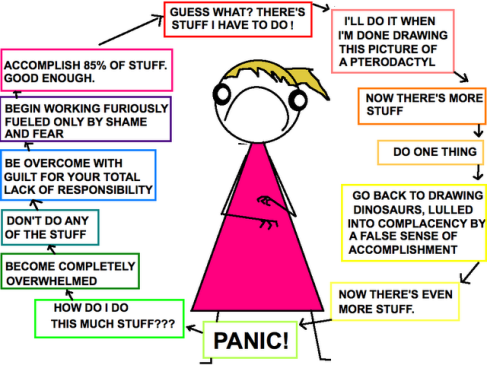I originally wrote this post for Beyond BookSmart, and it appeared on their blog on October 17, 2016: http://www.beyondbooksmart.com/executive-functioning-strategies-blog/7-self-regulation-tips-to-reduce-homework-battles-with-your-child. For other GREAT resources on executive functioning, planning and prioritizing, improving confidence, emotional regulation strategies, and focusing and attention strategies, check out the rest of the wonderful blog posts: http://www.beyondbooksmart.com/executive-functioning-strategies-blog
Few tasks test self-regulation skills like homework time. Self-regulation is critical to one’s ability to manage challenging or complex situations, and homework time is no exception. Strong self-regulation is multifaceted; it involves regulation of one’s thoughts, emotions, actions, and motivation. Although these skills continue to develop into adulthood, building and strengthening them from an early age can reduce stress and provide the drive to attempt new experiences. Students can integrate practices into home and school activities that strengthen and support a foundation of self-regulation. Below are seven tips students can use in their daily routines to promote happier homework time.
1: Make a homework plan
It doesn’t always make sense for your child to start with the homework assignment from his first class of the day. Some students feel more motivated when they get the biggest assignment out of the way first, while others need to get started with a small task in order to avoid a state of emotional overload. Encourage your child to first make a list of all tasks on deck for the day, and then arrange them into an order that will promote success. Setting aside a few minutes to make a homework plan before getting started can save time, frustration, and stress in the long run.
2: Stock your homework space ahead of time
A quick trip to find a sharp pencil can easily turn into an hour-long distraction. Before getting started, consider what supplies are needed to complete the homework and stock the workspace. Some students benefit from a tri-fold poster board used as a makeshift study station to reduce visual distractions. Wherever your child plans to complete homework, make sure the area is distraction-free and that the necessary supplies are readily available so precious work time isn’t wasted looking for more graph paper.
3: Support basic (subcortical) needs
The brain’s sub-cortex involves the “downstairs,” lower-level brain structures that manage emotions and generate seek and avoid impulses. When the sub-cortex is dysregulated, the brain devotes most or all of its cognitive resources to those structures in order to ensure that we feel safe and comfortable. This leads to decreased cognitive energy reaching the prefrontal, “thinking” parts of the brain that students need to successfully complete homework. Your child can support subcortical regulation by ensuring that he/she has had enough sleep, hydration, food, and movement.
4: Know your triggers and plan ahead
If a certain type of task is a consistent emotional trigger for homework battles with your child, encourage him/her to pre-regulate. This might involve intentionally setting up the environment to be as calming as possible, using a favorite pen or pencil to add a little fun to the task, taking some deep breaths prior to starting, identifying a small reward for completing the task, or setting aside time for a break mid-way through the homework. Anticipating the likelihood of dysregulation and planning ahead helps to avoid the emotional hijacking that otherwise feels like it sneaks up out of nowhere when students are working through an assignment they don’t enjoy.
5: Use future emotion to motivate present action
Often, students get stuck in a “now bubble” about how annoyed, frustrated, bored, or overwhelmed they feel at the thought of starting homework right now. It’s no surprise that these uncomfortable emotional states don’t provide much motivation to get started. Encourage students to shift their focus from how they feelright now to how they will feel when the homework is complete. Proud? Relieved? Accomplished? Use this future emotion to motivate the present action of getting started.
6: Snack smarter
Not all foods impact the brain’s endurance equally, and choosing the wrong snack can lead to a major blood sugar crash mid-homework time. Fueling up for homework is a great way to support the brain’s sub-cortex, and students should consider snacks that provide consistent energy to the brain and/or feed their sensory processing needs. Snacks with complex carbohydrates and protein-rich foods provide slow-release energy for the brain without the intense low soon after consumption. Chewy foods (e.g., dried fruit) and crunchy foods (e.g., nuts, whole-grain crackers, raw veggies) can provide sensory input for students who might otherwise feel distracted by sensory-seeking impulses.
7: Plan breaks wisely
The brain is most attentive for fifteen to twenty-minute increments. While some students can make it through marathon homework sessions, many need to break up the time to give their brains a rest. Breaks can be wonderful, but only if the student can successfully shift back to the homework task. Avoid break activities that involve nebulous timing (e.g., playing outside for a while) or ones that can’t be easily paused (e.g., video games that require the player to reach the next level before stopping). To avoid the drama of transitioning from a break back to homework, consider break activities that have explicit start and end boundaries(e.g., a five-minute YouTube video, twenty jumping jacks, listening to three songs, etc.). If vague end times can’t be avoided, set a timer to create a strict cut-off time.


















